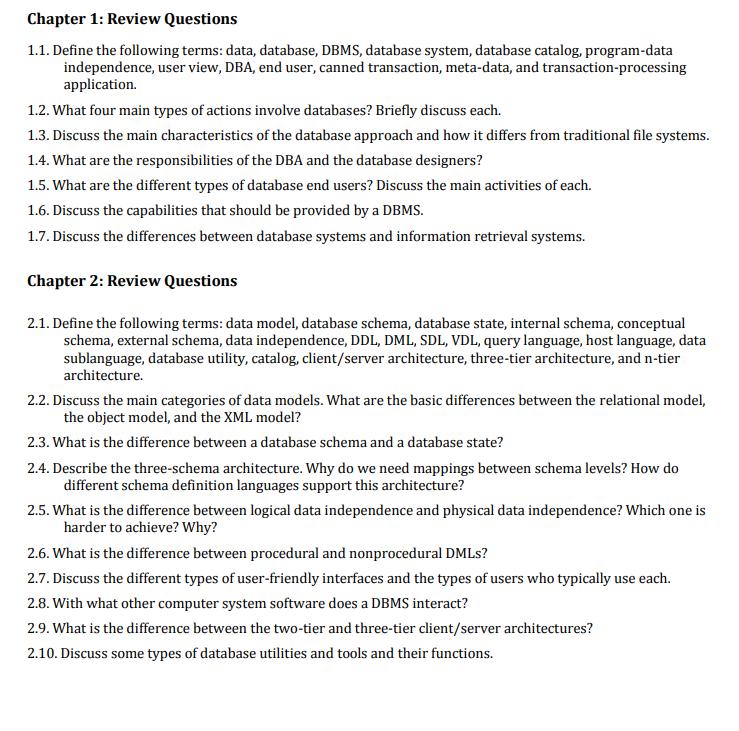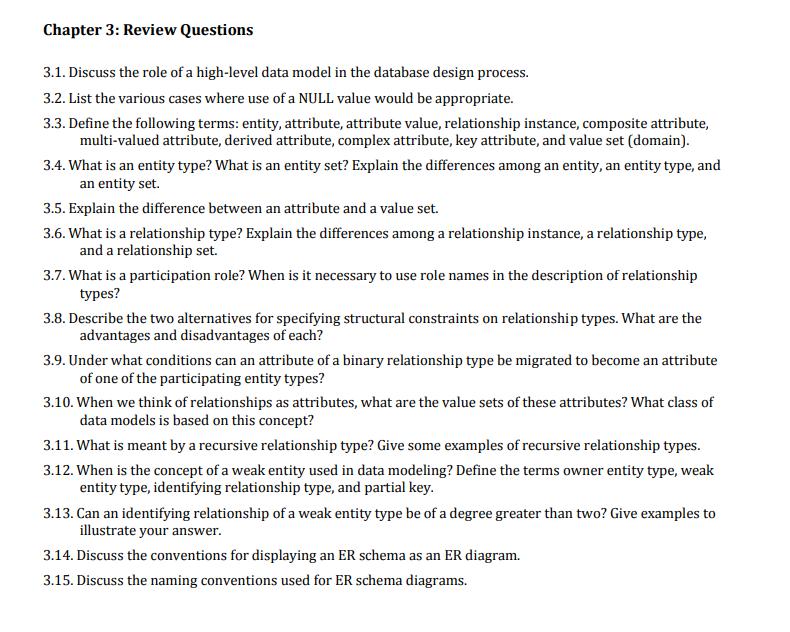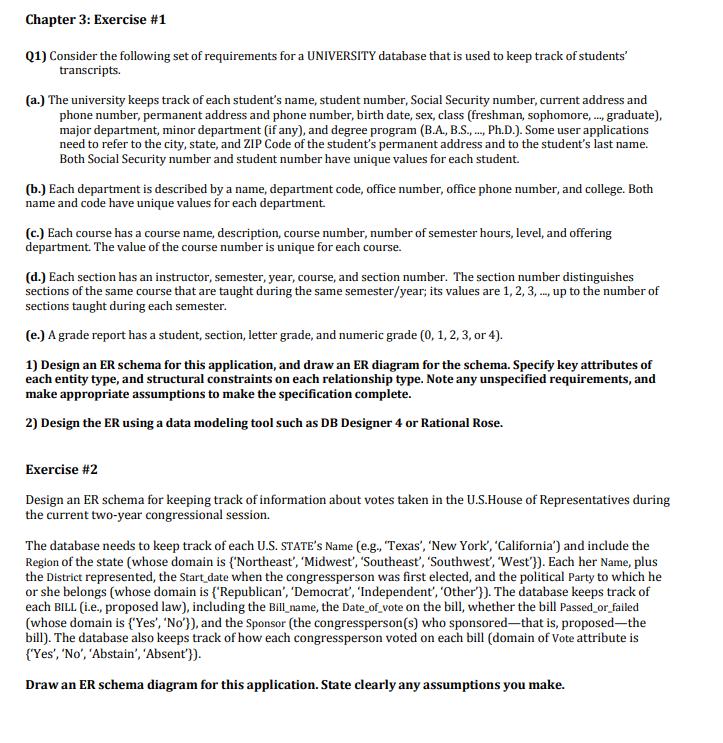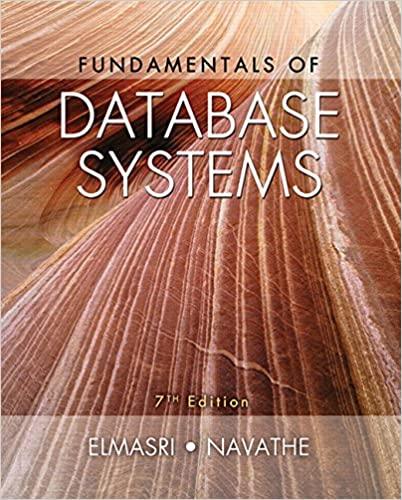Chapter 1: Review Questions 1.1. Define the following terms: data, database, DBMS, database system, database catalog, program-data independence, user view, DBA, end user, canned



Chapter 1: Review Questions 1.1. Define the following terms: data, database, DBMS, database system, database catalog, program-data independence, user view, DBA, end user, canned transaction, meta-data, and transaction-processing application. 1.2. What four main types of actions involve databases? Briefly discuss each. 1.3. Discuss the main characteristics of the database approach and how it differs from traditional file systems. 1.4. What are the responsibilities of the DBA and the database designers? 1.5. What are the different types of database end users? Discuss the main activities of each. 1.6. Discuss the capabilities that should be provided by a DBMS. 1.7. Discuss the differences between database systems and information retrieval systems. Chapter 2: Review Questions 2.1. Define the following terms: data model, database schema, database state, internal schema, conceptual schema, external schema, data independence, DDL, DML, SDL, VDL, query language, host language, data sublanguage, database utility, catalog, client/server architecture, three-tier architecture, and n-tier architecture. 2.2. Discuss the main categories of data models. What are the basic differences between the relational model, the object model, and the XML model? 2.3. What is the difference between a database schema and a database state? 2.4. Describe the three-schema architecture. Why do we need mappings between schema levels? How do different schema definition languages support this architecture? 2.5. What is the difference between logical data independence and physical data independence? Which one is harder to achieve? Why? 2.6. What is the difference between procedural and nonprocedural DMLS? 2.7. Discuss the different types of user-friendly interfaces and the types of users who typically use each. 2.8. With what other computer system software does a DBMS interact? 2.9. What is the difference between the two-tier and three-tier client/server architectures? 2.10. Discuss some types of database utilities and tools and their functions. Chapter 3: Review Questions 3.1. Discuss the role of a high-level data model in the database design process. 3.2. List the various cases where use of a NULL value would be appropriate. 3.3. Define the following terms: entity, attribute, attribute value, relationship instance, composite attribute, multi-valued attribute, derived attribute, complex attribute, key attribute, and value set (domain). 3.4. What is an entity type? What is an entity set? Explain the differences among an entity, an entity type, and an entity set. 3.5. Explain the difference between an attribute and a value set. 3.6. What is a relationship type? Explain the differences among a relationship instance, a relationship type, and a relationship set. 3.7. What is a participation role? When is it necessary to use role names in the description of relationship types? 3.8. Describe the two alternatives for specifying structural constraints on relationship types. What are the advantages and disadvantages of each? 3.9. Under what conditions can an attribute of a binary relationship type be migrated to become an attribute of one of the participating entity types? 3.10. When we think of relationships as attributes, what are the value sets of these attributes? What class of data models is based on this concept? 3.11. What is meant by a recursive relationship type? Give some examples of recursive relationship types. 3.12. When is the concept of a weak entity used in data modeling? Define the terms owner entity type, weak entity type, identifying relationship type, and partial key. 3.13. Can an identifying relationship of a weak entity type be of a degree greater than two? Give examples to illustrate your answer. 3.14. Discuss the conventions for displaying an ER schema as an ER diagram. 3.15. Discuss the naming conventions used for ER schema diagrams. Chapter 3: Exercise #1 Q1) Consider the following set of requirements for a UNIVERSITY database that is used to keep track of students' transcripts. (a.) The university keeps track of each student's name, student number, Social Security number, current address and phone number, permanent address and phone number, birth date, sex, class (freshman, sophomore, ..., graduate), major department, minor department (if any), and degree program (B.A., B.S.,..., Ph.D.). Some user applications need to refer to the city, state, and ZIP Code of the student's permanent address and to the student's last name. Both Social Security number and student number have unique values for each student. (b.) Each department is described by a name, department code, office number, office phone number, and college. Both name and code have unique values for each department. (c.) Each course has a course name, description, course number, number of semester hours, level, and offering department. The value of the course number is unique for each course. (d.) Each section has an instructor, semester, year, course, and section number. The section number distinguishes sections of the same course that are taught during the same semester/year; its values are 1, 2, 3, ..., up to the number of sections taught during each semester. (e.) A grade report has a student, section, letter grade, and numeric grade (0, 1, 2, 3, or 4). 1) Design an ER schema for this application, and draw an ER diagram for the schema. Specify key attributes of each entity type, and structural constraints on each relationship type. Note any unspecified requirements, and make appropriate assumptions to make the specification complete. 2) Design the ER using a data modeling tool such as DB Designer 4 or Rational Rose. Exercise #2 Design an ER schema for keeping track of information about votes taken in the U.S.House of Representatives during the current two-year congressional session. The database needs to keep track of each U.S. STATE's Name (e.g., "Texas', 'New York', 'California') and include the Region of the state (whose domain is ('Northeast', 'Midwest', 'Southeast', 'Southwest', 'West'}). Each her Name, plus the District represented, the Start_date when the congressperson was first elected, and the political Party to which he or she belongs (whose domain is ('Republican', 'Democrat', 'Independent', 'Other'}). The database keeps track of each BILL (i.e., proposed law), including the Bill_name, the Date of vote on the bill, whether the bill Passed_or_failed (whose domain is {'Yes', 'No'}), and the Sponsor (the congressperson(s) who sponsored-that is, proposed-the bill). The database also keeps track of how each congressperson voted on each bill (domain of Vote attribute is {"'Yes', 'No', 'Abstain', 'Absent'}). Draw an ER schema diagram for this application. State clearly any assumptions you make.
Step by Step Solution
3.42 Rating (174 Votes )
There are 3 Steps involved in it
Step: 1
Answer 11 Answer Data all the single data that are stored in the database Database all collection of data management with ease of access DBMS database management system is nothing but to perform query ...
See step-by-step solutions with expert insights and AI powered tools for academic success
Step: 2

Step: 3

Ace Your Homework with AI
Get the answers you need in no time with our AI-driven, step-by-step assistance
Get Started


